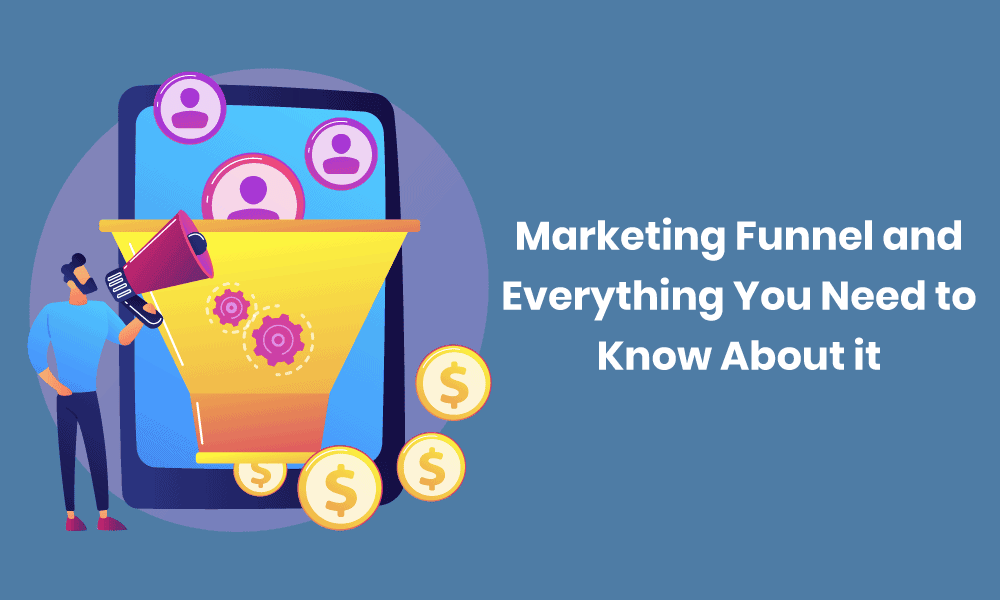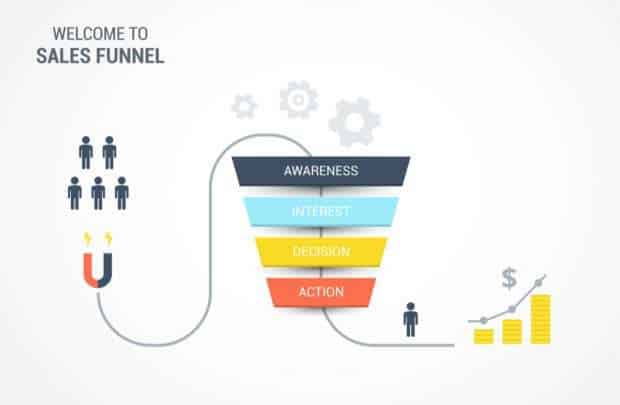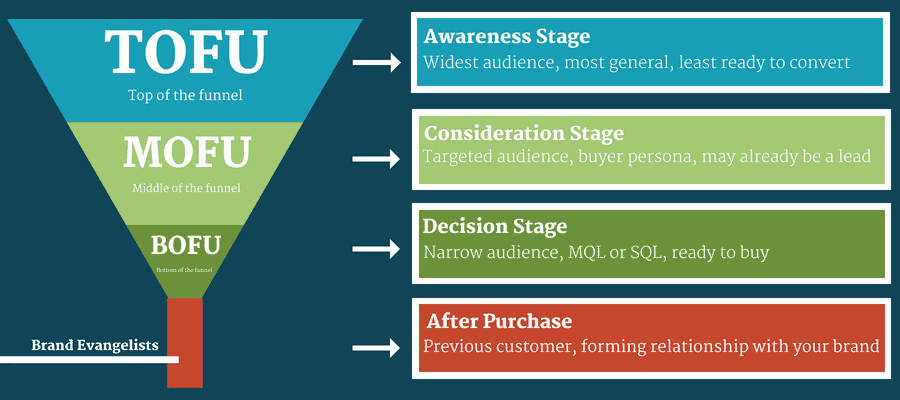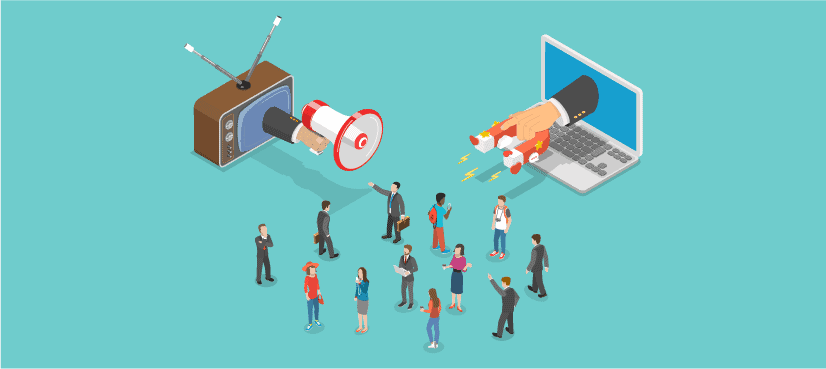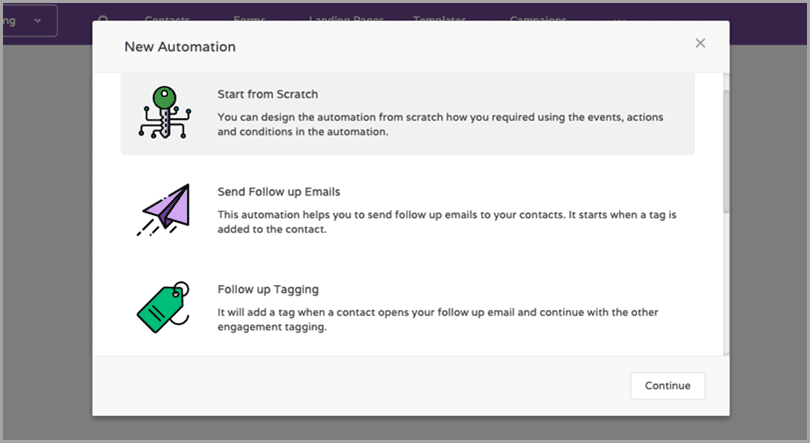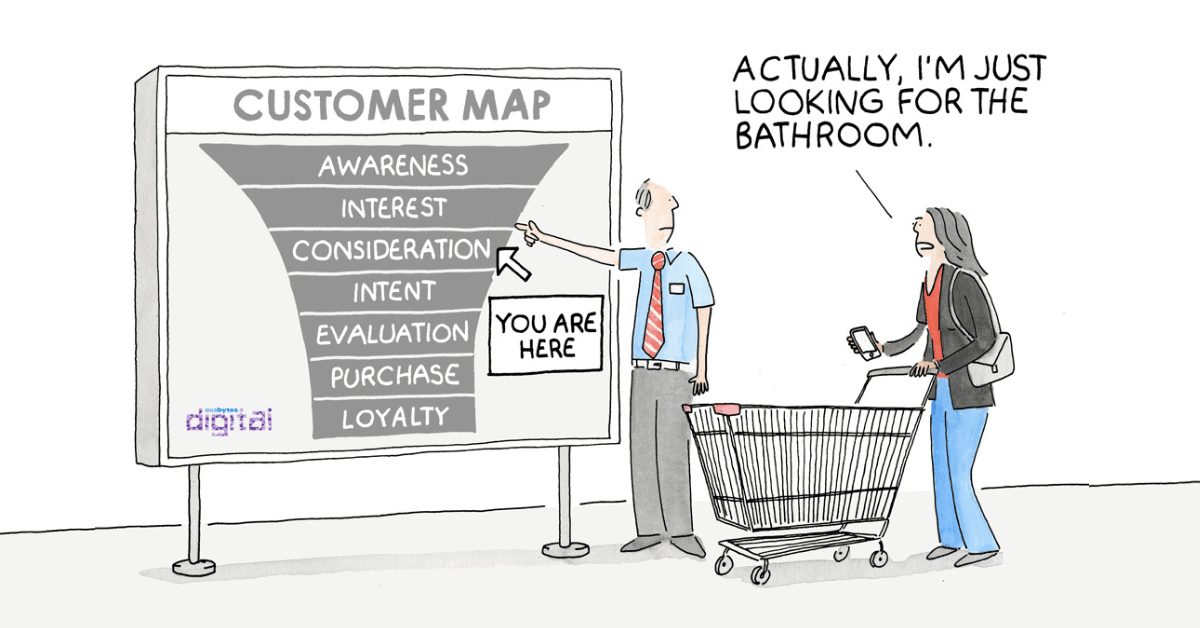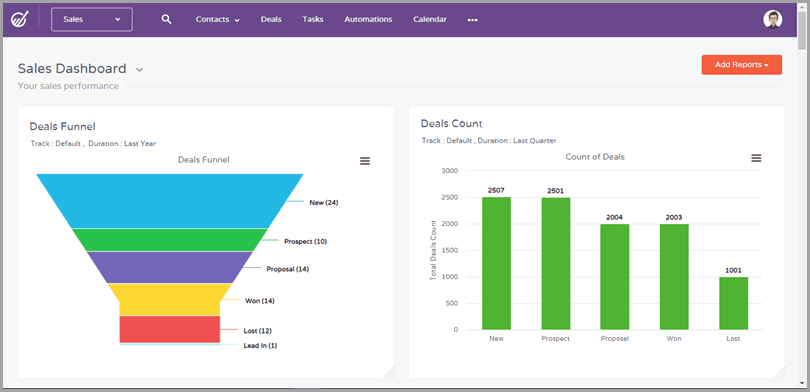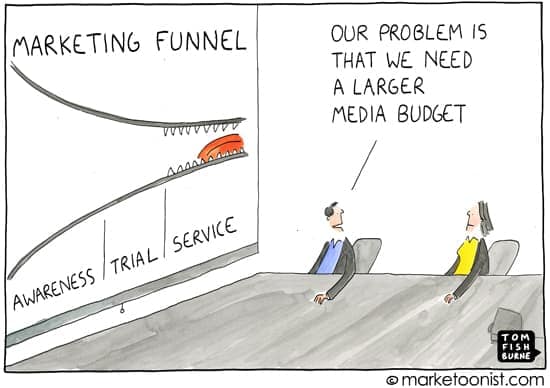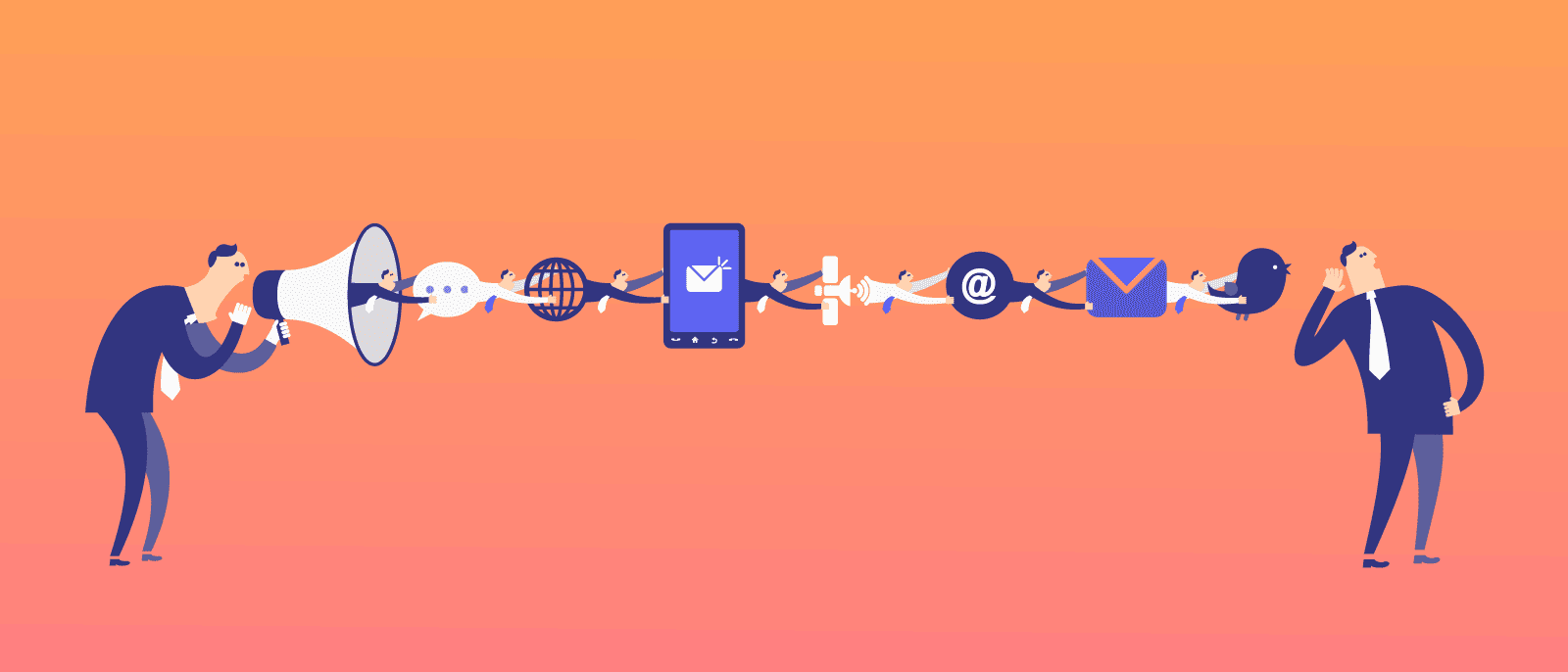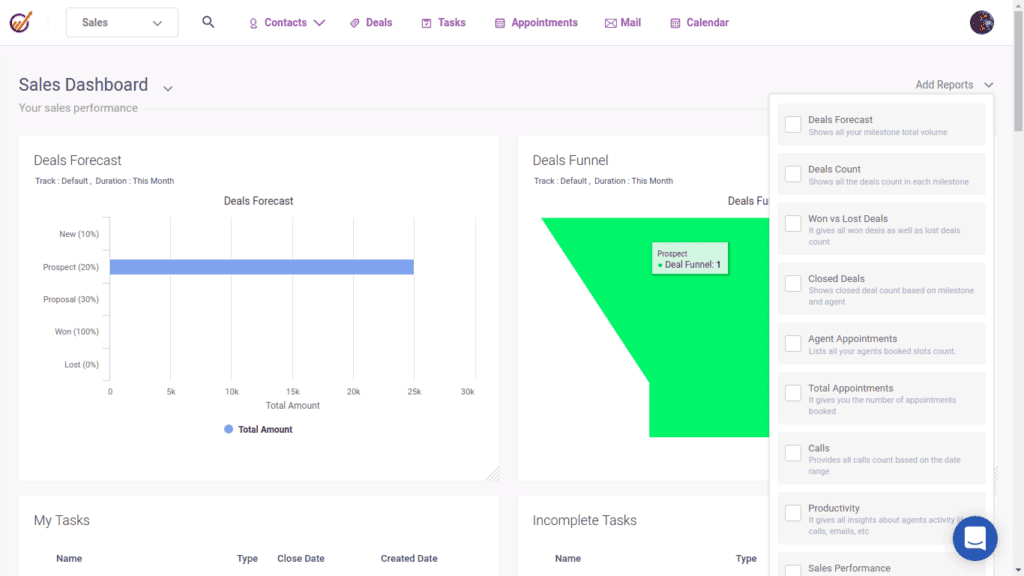Before we start with how a marketing funnel works, let us first understand the need for these marketing funnels.
You may be surprised to know that only 2% of the purchases made by your target audience happen at the very first contact.
Okay, you probably knew this, it isn’t easy to convert a lead into a client, but any guesses on how exhausting and long can this purchase process get?!
On average, in a customer journey, your whole purchase process requires 5-8 touchpoints before your potential customers can make the decision of moving from a lead to a prospect and eventually a buyer.
Thus, it’s clear that selling a product is not a child’s play. You would need to ensure that your customers are happy with your company at every stage.
This is where marketing comes into play!
To do this the right way, you would need to build a marketing funnel.
Table of Contents
What is a Marketing Funnel
A marketing funnel is a process of breaking down the customer journey from ‘the brand awareness stage’ i.e. when the customer browses and becomes acquainted with your product to ‘the purchase stage’ i.e. when the customer has bought your product.
This can also be described as a practice that recognizes the journey of your target audience from potential customers to ACTUAL customers.
It gives you an idea about the customer’s behavioral pattern that leads them into purchasing your product.
It is like having a visual flowchart of how the customer thinks and what leads them to eventually buy your product.
Marketers advertise and introduce their products to seize maximum customers.
However, not every person you reach out to will become your customer, and that doesn’t mean you leave them out.
A marketer knows that someone who may not be so interested today can become interested tomorrow, and so, one primary job role of a marketer is to generate leads and nurture those leads over time to convert them into prospects/potential customers.
Image Courtesy: Teachable
You can think of the marketing funnel as a virtual one with a filter at every stage, as a lead seeps down the funnel, it gets all the more refined for the business.
Marketers strain the leads through each stage of the funnel to attain clients.
Ideally, the marketing funnel should rather be a marketing cylindrical, turning all leads into clients, but in reality, this is difficult to attain.
By proper evaluation of a funnel, the marketing experts can forecast the company’s revenue, sales, and brand awareness.
We often use words like “lead” and “client” while explaining marketing. It is important to understand the difference between the two.
A marketing lead is a person who shows interest in your brand’s product or service. A lead can be a potential customer.
The primary focus of any business is to generate as many leads as possible.
A client, on the other hand, is a person or an organization that buys what your brand is selling. A lead is not a client until he has paid you for your product.
Moreover, it doesn’t always imply that every lead will buy your products.
This is where your marketing and sales team further diversifies your leads, and we are going to get there later, but for now, let us help you understand what separates a lead from a client.
For example, you are the owner of a newly opened bakery.
Your primary motive is to create awareness about your bakery. Let’s say you start by using Instagram and Facebook ads.
Your ads will attract a new audience.
Let’s say a person explores your ad, they are directed to your website’s landing page, where they can sign up.
Right now the people exploring your website are your leads.
Now, the lead enquires about different types of cakes and desserts at your bakery.
The leads are now turning into prospects. A prospect is someone who has shown an inclination towards your product and is more likely to buy than a disinterested lead.
The prospect visits your bakery and purchases a brownie.
The prospect is now your client. When the lead pays for your brand’s product, they become a client.
Hence, the journey of your customer from a lead to a client is not complete until they don’t buy what you are selling.
Your job as a marketer is to turn your customer into a happy customer. That is the only way to get clients to visit you regularly and make proactive loyal customers.
You could do that by maintaining contact with your customers via social media, newsletters, regular emails, etc., informing them about what’s new in the store.
Not a big fan of reading? Watch this video instead:
Why Is A Marketing Funnel Important?
You may be wondering if going through all this planning is worth it. Surveys and research across the globe say it is.
Having a marketing funnel helps you bring more system and order to your deal pipelines.
The following are a few of the various benefits one could associate with having a marketing funnel:
Helps your marketing and sales team coordinate
They are all part of this one giant process which is aimed to bring revenue.
Marketing and sales, however different, have to work in perfect coordination for your business to grow properly.
However, often times, both the departments seem to be dancing to their own tunes.
On a marketing funnel, everyone knows the stages which a consumer goes through and this is very helpful when it comes to delegating roles and holding people accountable.
Map your customer journey
When you do not have a set funnel in place, you do not have a set customer experience roadmap to follow.
This means some deals may go cold, some may get lengthy, and some may even get lost.
To make sure your customers do not waste their precious time in complicated random processes, narrow down how would they be transitioning from one stage to another.
Set the minute details to perfection and you will see your conversion get faster.
Brings visibility to your sales cycle
Every business has a sales process but often times, it goes poorly mapped.
When you have a marketing funnel, you know exactly how your sale cycle works right from the lead generation to your lead conversion stage.
Helps you remove the bottleneck
When you think about your sales cycle, you envision this linear flow of going from a lead to a prospect to a consumer.
However, between each of these three stages, a lot many leads slip.
When you make a funnel, you see the bottlenecks and the churn-out points as well.
Seeing them visibility prominent in your sales cycle would help you strategise on how to remove them.
What this means is you will actively set the right expectations, monitor the challenges, and work on removing anything that stops you.
Read also: Here’s What Micromarketing Means, and How It Can Help Your Business
The Various Models of a Marketing Funnel
Over the years, there has been constant debate over the basics of the marketing funnel.
Although there is no universally accepted model that describes the marketing funnel best, new-age marketers have been using a simple ‘TOFU-MOFU-BOFU’ strategy to describe the funnel.
It refers to the top of the funnel, the middle of the funnel, and the bottom of the funnel.
All stages have their distinctive features.
TOFU is the stage where the marketer generates brand awareness and informs the target audience about the problem that the brand’s product addresses.
It is important to be specific with your target audience.
Not everyone will buy your product, but the people who relate to it, may. If you keep your target audience broad or vague, you will not achieve the desired results.
Thus, it becomes crucial to narrow it down on parties that are most likely to buy.
While you spread awareness regarding your product, it should constantly be in your notice who’s reflecting interest to know more and not.
The buying process is awfully long when you’re dealing with disinterested people, but you can rather slide through it if you prioritize hot leads first.
In the MOFU (Middle of the Funnel) stage, the marketer’s role is to help the lead choose a solution.
At the BOFU (Bottom of the Funnel) stage, the marketer has successfully persuaded the prospect into choosing his product. Sale won!
However, there are various stages in a funnel, and TOFU-MOFU-BOFU model over-simplifies the buying process.
Let us get to know each stage involved in a general marketing funnel.

What are the Stages of a Marketing Funnel
The journey of a customer from starting out as a lead to becoming a prospect, then eventually converting into a client can be explained through 8 funnel stages.
Image Courtesy: WabAscender
Awareness
This is the primary stage of lead generation. Potential buyers are recognized at this stage through awareness campaigns and consumer research.
Businesses showcase themselves in the market at this stage to open gates for leads.
Advertisements (print and digital), events, social media platforms, blog posts, direct mail, webinar, trade shows are some of the ways to gain trust and establish awareness in the market for lead generation.
Interest
Lead generation brings in the interest stage. Here, the leads learn more about the brand and its products.
This is that stage where a marketer tries building a relationship with the people in his lead’s database with the intention of introducing the benefits of using his product.
Marketers nurture their leads through direct email marketing, targeted landing pages, and newsletters.
Consideration
Here the leads have been converted into marketing qualified leads i.e. the lead is already a prospect because they have expressed interest and they are more likely to buy a product than other leads.
At the consideration stage, the marketer passes more information to the prospect about his company and its products, and nurtures them through targeted content, free trials, and case studies.
Intent
At the intent stage, the prospect has presented their desire to purchase your product.
Their decision to buy can be visible in the form of a survey, which you can email them right after the product demo or free trial, or when they add your product to the shopping cart in case of an e-commerce website.
The intent stage is also an opportunity for the marketers to educate the soon-to-be consumer on why is their brand’s product a smart buy.
Evaluation
This is the final stage of decision-making, and this is where a buyer decides whether or not your company’s product is worth the purchase.
Here the marketing and sales team work together to ease a customer into the buying process and make them believe that their brand’s product is undoubtedly the best solution for their problem.
Purchase
At this stage, the prospect has bought the product and when that happens, they are no longer a prospect but a customer now.
Your sales team will take it from here.
Delivering a positive experience to your clients during the buying process can get you referrals and help in faster lead generation.
The better your services, the more likely are you going to hear back from them and the higher the chances that they will purchase more from you.
Loyalty
You can maintain your relationship with your new and old customers through regular discounts, infographic mailers, and social media posts.
Someone who has chosen your brand once has preferred it over your competitors at least once. Thus, it becomes easier to get them hooked.
They already trust you! While you should aim for newer leads, retaining older buyers is easier than getting new ones. Thus, you should aim for repeat sales.
Advocacy
Once your customer has moved from the loyalty stage, they can either be active or dormant loyal customers. You want active loyalty.
Loyal and repetitive customers bring you referrals and support your future marketing funnel through new lead generation.
However, to get them to this stage, you have to ensure that your services make them so happy, they themselves volunteer as your advocates; they no longer feel like you are a firm but a part of their family.
You can use a loyalty programme and reward them with cashable points everything an existing customer shops with you.
The better your loyalty program, the higher their interaction.
At this stage, a customer would openly talk about how great you are via social media or word-of-mouth, and may leave a positive testimonial without being requested to do so.
If they do not, you should make sure your company representative, incharge of handling this buyer, gets their word in.
While these eight are the most common stages of the marketing funnel, the stages can vary as per the business.
However, the funnel is no more linear these days.
The customers come, go, and rejoin at different funnel stages. There is no set pattern to the flow of customers changing from leads to clients.
For example, if the target audience heard about the brand’s product and joined the funnel through referrals, then they are most likely to join at the intent stage where they have already turned into prospects.
As the prospects already have the desire to purchase the brand’s product, they are just left with the evaluation of the product before purchasing it.
Sometimes the customers join in the interest stage because they have researched and educated themselves about your brand’s product through the internet.
This is why it’s important to work on your website’s visibility and improve your search traffic.
Due to technological advancements and easy availability of the internet, most of the leads are already well-informed about the product and services that cater to one’s needs.
Read also: Maximizing Inbound Marketing Automation For Exponential Growth
Inbound Marketing Sales Funnel
Traditional marketing is the way of sending a generic message through advertisements to mass audiences ignoring the basic question about whether or not are they even interested to know about your brand’s product.
Inbound marketing has decided to do away with how vague traditional marketing is with a broader approach.
It is a new technique that targets specifically the prospects, i.e., the audience that already has a desire for your product.
To put it more aptly, the audience that has a desire for the solution you offer, since they are faced with the problem you cater to!
Did you know that about 80% of online search traffic is targeted on finding solutions for problems?
By providing highly educational and informative content you can point that large group of audiences towards your website and expedite the purchase.
This will increase your leads and prospects.
Inbound marketing sales funnel uses highly designed and sophisticated content to lure specific prospects onto the brand’s website.
The content is highly educational and personalized to the needs of your prospects.
You take the help of online channels like blog posts, search engine optimization (SEO), email marketing, e-books to help prospects find your website.
Image Courtesy: Clariant Creative
There are two major problems for the sales department: Getting the leads to respond, and identifying the prospects.
Inbound marketing funnel addresses both the problems by targeting specifically the prospects, completely eliminating the step of lead identification, and thus, allowing the sales guys to focus their efforts on people who are more likely to buy your product or services.
Another advantage that you see here is you do not lose way too many leads through your funnel stages.
You do not have a cutting bottleneck which opens up in a tapper bottom of the funnel.
You will end up retaining most of the qualified marketing and sales leads you began with despite the various stages.
Automation is one of the many key roles that differentiate inbound marketing sales funnel from a regular marketing funnel.
For instance, an automated email directed towards each prospect helps in nurturing them into clients.
Not only does an automated email save time, it also give the sales team insights on how the prospects are engaging with their content whether the prospects are downloading the content from the email, filling out the surveys, and visiting the websites.
All the feedback they provide to your email can help you better the purchase process.
EngageBay’s Marketing automation software platform helps small businesses automate marketing and sales tasks and various workflows to generate leads.
Here are some inbound marketing tips, which can help you attract, engage, and delight your target audience.
Attracting Strategies
Inbound marketing uses valuable and informative content to attract their prospects.
Therefore the first step is to create and publish educational blog posts, social media posts, and informative articles that hold value.
A blog post should include information about the product, how it will solve your lead’s challenges, customer testimonials to gain trust and make it promising.
Use an SEO strategy (Search Engine Optimization) and unleash the power of correct keywords into your content to make it appear on top of the SERP (search engine result pages).
Engaging Strategies
There are various ways through which you can engage your audience. Keeping an active social media brand helps!
You can organize regular polls and quizzes by using a quiz maker tool as an effective part of your engagement strategy.
You should use every channel to ensure your customers believe in your products.
You could make phone calls or virtual workshops to further connect with your audience.
Though some may perceive emails as formal, but you will be surprised at how 75% marketers vouch for email marketing.
With a personalized email campaign, you can make sure your customers receive and send vital information regarding your brand.
If done right, an email can help you grow your social media and blog too. For instance, you can share the link of your new blog post via an email newsletter.
However, for this too, you will need an email list. So, whenever you get a new lead, make sure to have all their details (email address, demographics, phone number, spending habits, etc) and save them in your database.
Sounds like a lot of work? Not with a smart CRM like EngageBay, an all-in-one marketing and sales solution for you!
TRY NOW!
You should also go for customer care calls, you can make them believe that your brand’s primary focus is on achieving solutions rather than just maximizing your sales.
Make your prospects believe that your goal is to build a long-term relationship. You should be able to offer them value.
Delighting Strategies
Delighting inbound strategies are exclusively used to make sure that the customers are happy and satisfied with the brand’s product and service long.
The company’s representatives become friendly advisors for the clients and assist them in solving the challenges they may face with the product.
One of the best ways to ensure this is by sending regular questionnaires and survey forms via email to the customers regarding the product.
Opt for a personalized email address to attract more response. You are more likely to open emails from a Jenny or a Dave, than a cold email from “no-reply@XYZ”.
24X7 agile chatbots on your website can help you address customer queries.
We can also divide these strategies as per our TOFU-MOFU-BOFU model as well:
Top of the funnel marketing
People at the top of the funnel are the largest in number, however, we have established that it doesn’t imply the whole group is looking forward to your product.
At this stage of the marketing funnel, you are going to educate them and see if this can turn into something advantageous for both parties.
They should love your product and you should make your profits. Win-win!
Social media (Facebook, Instagram, Twitter, YouTube) is where the audience goes to discover new things, making it the ultimate hotspot, where marketers generate awareness among the target audience.
Digital ads cover 90% of the internet today.
When your target audience subconsciously sees your brand’s ad throughout the day, they automatically become familiar with your brand’s product.
You can track how your PPC or PPV ads have been doing via Google analytics.
Middle of the funnel marketing
After making your audience aware of your existence in the market, your marketer would try and tell your audience why you rock.
This is where the consumer develops a desire for your product and starts to research.
Today’s consumer is a learned guy, and he can easily dig up some dirt on your name.
The internet has a good memory when it comes to finding stains on your reputation.
So, please ensure that you maintain a good reputation and provide the most pleasant services to your masses.
Middle funnel marketing strategies include SEO marketing, paid search ads, video marketing, and email marketing.
SEO (Search Engine Optimization) marketing
SEO is the best way to gather organic leads. Today’s buyer is constantly searching for a solution to a specific problem on the internet.
The best way to make sure that your website appears on page one of Google search is by using effective keywords.
Neil Patel says one of the most effective marketing tips is being organic, which you can do by using a blog post, features, and customer testimonials that answers almost every query your target audience.
This helps the prospects to even trust your brand as you are directing advertising yourself.
Paid search ads
Whenever you want to know more about something, you can just search about it on Google.
Paid search ads make it easy for prospects to know about your brand.
When brands use paid search ads for a blog post or a landing page, they appear on the top of the result’ page for their relevant keywords.
Video marketing
The average attention span of your audience is 8 sec.
So, the best way to catch your audience’s attention is to make 30 second videos that describe the product, its uses, and how to use it.
No one is going to read a long post these days, no matter how beautifully you crafted it.
However, we might just sit through a good-looking and well-sounding video.
You could use these videos in your next email campaign too.
Just embed the YouTube video on your email, you might even gain a few subscribers on your channel if the video is really good.
Email marketing
In this method, you email newsletters, blogs, discounts, and more to your customers.
This helps you maintain a professional touch while also being there for your gathered leads.
Bottom of the funnel marketing
This is the ‘do’ stage where your prospects finally change into your customers.
The ‘do’ stage is followed by the ‘care’ stage where the revenue-building loyalty loop is formed.
At the bottom of the funnel, you have to be specific about the content you produce as that is going to trigger your customers into action.
You need to ace the when and how of the content delivery as well.
Why do you Need a Marketing Funnel
Customer journey isn’t just for the customer, but for the company and its marketers too!
Here we will talk about some key points that will tell you the significance a marketing funnel holds in your business.
Image Courtesy: Exabytes Digital
Generate more sales
Having a marketing funnel will help you understand the wants and needs of your target audience better.
A thoroughly studied funnel will help the marketer generate more leads, and hence, more sales.
The principle idea is to pull your audience systematically towards your desired outcome.
You can automate it
Technologies and software today help you automate the journey of your prospects into clients. It saves the brand from the hustle of regular lead follow-ups.
This saves a lot of time for your sales team. You can use CRM tools such as EngageBay to send automated reminders and notify to your team for when a client call is pending.
With smart and robust tools, you can automate nearly 75% of your marketing funnel stages.
You could use various automatic hacks such as bulk automated emails to help your leads feel connected with you.
EngageBay’s free CRM solution helps you organize all your email contacts, track deals and the sales pipeline to grow your sales.
Improves your lead quality
The primary agenda behind a marketing strategy is generating leads that turn into your consumers.
Providing content with which the target audience can relate to will build up their trust and enhance their purchasing decisions.
Leads that are nurtured with quality content would at least become subscribers.
They may reach the brand ready to buy, the higher quality your leads have, the less likely are they to negotiate or drop in the middle or waste your time.
The edge against new entrepreneurs
Well-built marketing funnels will help you attain a competitive advantage over new entrepreneurs in your field.
The idea of lead generation and secure database will always be favorable against the newbies in the market.
Helps you to grow your business
The feedback stage of the marketing funnel is an important tool for understanding the positive points and negative points of your business.
It helps you understand where you lose the lead.
For example, a prospect has a desire to purchase from you but ends up purchasing a similar product from a different brand.
A feedback form or survey can indicate where they bought and why they did so!
Your next step is to clear this roadblock to maximize your sales.
Hence, the marketing funnel is a useful tool for helping you grow your business.
Scaling of content
Once the funnel has matured i.e. it is tried, tested, and optimized to generate leads, and increase sales, you can scale your advertisement and content accordingly.
Moreover, there is always a possibility of reusing the content if the previous strategies worked fine.
An important aspect of having a marketing funnel is diversification.
You will also diversify within your lead group and push various email marketing campaigns based on the interest, demographics, and previous purchase data.
You can make this distinction in your email lists as well.
More referrals
Your clients haven’t bought your product solely because it the best or the most price-efficient in the market but because your marketing resonated with their personal values.
If you continue to foster them, they will be your advocates or self-proclaimed ambassadors who promote your product to their friends, family, and colleagues.
These clients are most likely to leave a positive review for your brands on various social media and review forums.
Data and insights
Your sales and marketing team need data and insights to analyze content, design, or media that will suit the prospects.
This involves focusing on prospects that prove to be more cost-effective or rather figuring which ad needs to be displayed to the prospects based on their search behavioral pattern.
If the data and insights are acted upon, they can maximize your ROI.
Build a sense of pride and love for the business
A mature funnel will bring a sense of pride, accomplishment, and love for the business.
The emails, posts, videos, adverts, customer testimonials, reviews, and all the other strategies you build as a part of your funnel will deliver a sense of pride for the company and motivate your sales and marketing guys to sharpen their skills even further.
Marketing strategies are reusable and replicable.
All the hard work that may have gone into making blog posts, videos, content, landing pages, case studies, and testimonials is the brand asset.
This can be reused when the brand is starting with the marketing of a new product or service.
Hence, all the money spent on marketing funnel will help acquire valuable assets for your business.
Moreover, if the strategy works fine, you get to use the same funnel the next time.
Mistakes People Make With Their Marketing Funnel
You may by now think that the concept is fairly simple. However, not everyone gets THE FUNNEL right!
Here are some common mistakes people make with their draft of a marketing funnel:
Image Courtesy: Marketoonist
Misinformation
Not giving the right kind of information, or holding some relevant details behind can jeopardize your strategy.
It is important for you to understand that your leads should get a brief about you through your landing pages, blog posts, and content.
Leaving a lead confused is a pretty definite way of losing the lead.
Do not play hard-to-get!
Imagine walking into a showroom and finalizing a product only to realize they do not sell on counter A, they sell on counter B, however, the machine is broken so you must wait.
Do you wait?
Most customers will not if your website does not give them a clear direction and a quick response.
While building your marketing funnel, you should ensure that every lead follows through smoothly without technical glitches blocking the purchase.
Perseverance!
A lead might seem like a time-waster since they didn’t make a purchase right away, but what if they eventually do someday.
Customers are usually looking for persuasion and encouragement before they decide to commit to your brand.
Therefore, it is important to follow up with the leads, even if they are not qualified leads.
This is where you will need to train your company representatives right! 82% sales reps do not make a third call, no wonder the customers don’t feel nurtured!
In case of b2b consumers, you may be looking at months of calls before the final purchase.
Old is STILL Gold
Most of the brands put in too much emphasis on finding new customers.
Finding new customers can be exciting, but it can be difficult too.
However, when you focus on your current customers, you do not spend as much, and yet, you maximize your revenue.
So, do not forget your old customers while building your funnel.
In an ideal situation, your attention should be divided equally between your current customers and your prospects.
Keep a Simple Plan
Too many cooks spoil the broth, and so, you should keep it uniform and singular.
Any unnecessary content will only make it difficult for your prospect to reach the bottom of the funnel.
It is important to convert your leads into clients as quickly as possible because the lack of urgency makes the lead feel that progression is not important.
You can inspire urgency in your leads via strong email follow-ups.
The good thing about choosing email marketing is that it serves a multiple purposes.
You can use it to get leads, convert leads, follow-up, take feedback, and what not!
However, to use anything smoothly, you need a simple plan.
Be There For Prospects
Providing content and support throughout the funnel can be challenging, but can’t be compromised with.
Marketers are focusing on generating traffic (top of the funnel) on the website, but it is important to also answer the questions of the prospects regarding your product (middle-bottom of the funnel) as well.
Filter Your Process Too
We know you may feel that more the leads, merrier your chances!
However, maximizing the volume of leads is not the agenda.
The agenda is lead conversion.
Choosing the wrong audience will not help in generating revenue.
Don’t Overlook Marketing Opportunities
Your target audience can’t find you if you simply post your content online, it is important to advertise yourself.
Make use of social media tools, reach out to influencers, and engage with important communities.
Remember the open-ends of the marketing funnel are what matter the most, so you have to work on the top just as much as you do on the bottom.
Don’t Stop At Closures
The job isn’t done when the leads are converted into clients!
This is one of the most frequent mistakes made by even the best expert marketers.
Turn your client into your lifelong customers by checking up on them, sending them helpful guides, and keeping in touch with them whenever possible.
If the client purchases from you regularly and advocates your product, you have finally made it to the conclusion of the marketing funnel.
Businesses don’t shine overnight.
Be patient with your marketing strategy.
Campaigns need time to grow before they can produce successful results. Continuity and sticking to a particular marketing plan is important.
Leaping from one strategy to another is fruitless. Investing time on strategies before they take off is important.
What Can You Do to Make a Better Marketing Funnel
Image Courtesy: Lucidchart
Choose which stage of the funnel to start with
You may already have a lead collection procedure in full swing, this means you need to start from what follows after it.
You know best where your business is, that should be a decisive factor in choosing where to start on your marketing funnel.
If you have a ripe marketing funnel and have a constant flow of prospects desiring your products, focus on the bottom of the funnel to increase sales, and generate revenue.
On the other hand, if your business is not generating sales currently, it would be better for you to work on the top of the funnel.
Focus on generating leads that you can nurture into prospects and clients with time.
The trick is to focus on one stage at a time. Do not start working on the entire funnel from start.
Pick one or two tactics for each funnel stage
There are a lot of strategies to go about on each stage of the funnel. Video marketing, email marketing, customer testimonials, case studies, landing pages, blog posts, social media, webinars, free samples are a few of the many tactics.
Pick one and focus on it exclusively to maximize your results.
You can pick another if the one you chose doesn’t work for you, however, doing everything together is not going to help!
Create content for each tactic
For example, you start with video marketing.
The best way is to make 30 sec informative videos and upload them on YouTube.
You would find it much better if you also promoted your YouTube video on your other social media handles, to help the video reach more people.
Connect and build continuity
None of your marketing funnel stages can work successfully without being synced to your final goal. You need to be sure of what each tactic is doing for your overall brand.
Thus, your emails need to direct people to a blog, which can help them understand you better.
The blog can have a CTA for them to shop.
The shopping link will also send an email when they add products to the cart.
You see, this is how each tactic works in a continuum with one another to fulfill the greater purpose.
Usage of better CRM tools
CRM stands for Customer Relationship Management and is a customer-oriented software, which is responsible for building and managing the company’s relationship with the leads and prospects too.
Its goal is to enhance relationships, nurture sales, and convert leads.
CRM is the tool to help business owners track their leads and current customers.
You can use CRMs to automate your funnel as the lead moves down from one stage to another till it finally ripes into a customer.
EngageBay is an all-in-one marketing and sales CRM to help you draft the marketing funnel.
CRM is important in understanding customer’s behavior, making it easy for marketers to understand when and what product should be introduced to the leads.
It helps you identify the leads that will convert so that you don’t waste your time on the non-profitable leads.
Hence, CRM is an important tool in boosting your sales as you can gather so much information about your target audience.
EngageBay is an all-in-one marketing and sales CRM to help you draft the marketing funnel.
You would also get top of the class customer support features to ensure everything right from the start till the end of your deal closure and even after that goes smoothly.
In short, marketing funnel depicts the planned journey of your target audience from being unknown and unaware of your brand to purchasing your brand’s product.
It is important to know that although leads will be lost in each stage of the funnel, some will be nurtured into loyal clients too.
Every business, big or small, should apply the funnel technique to come closer to understanding their leads and thus generating sales.
Hence it is useful to know about marketing funnel regardless of your knowledge of marketing.

